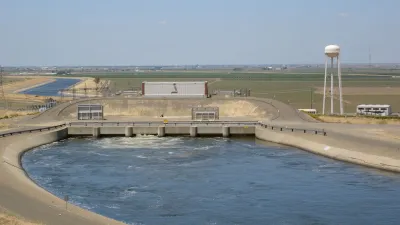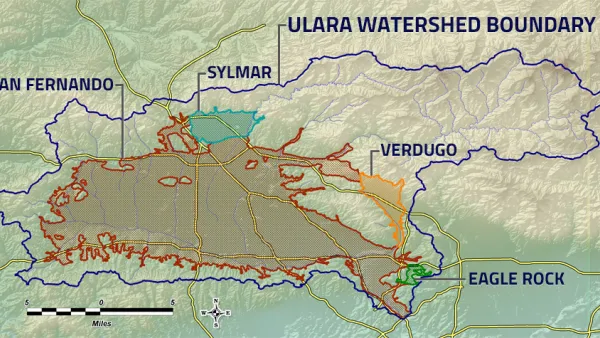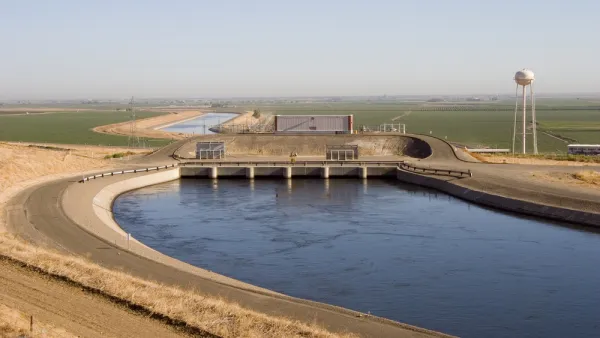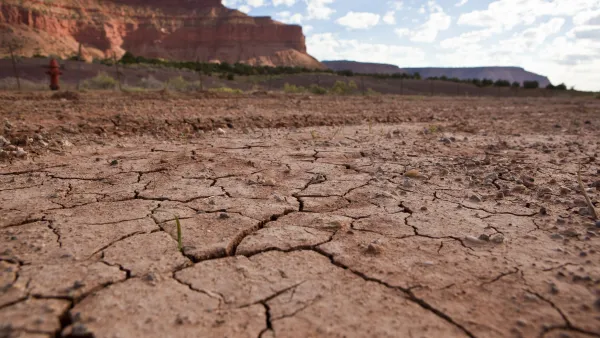The region has poured over a billion dollars into storage infrastructure and demand management policies in anticipation of worsening drought conditions.

Despite Governor Newsom's recent warning that California is, once again, facing drought conditions, reports Laura Bliss for Bloomberg Green + CityLab, "highly urbanized Southern California has a record 3.2 million acre-feet of water in reserve, enough to quench the population’s needs this year and into the next." This reserve is "thanks in large part to tremendous gains in storage infrastructure and steady declines in water use — driven by mandates, messaging, and incentive programs — belied by the region’s storied reputation for thirst."
Over the last two decades, Southern California "has invested more than $1 billion in new storage infrastructure, including a nearly trillion-liter reservoir at Diamond Valley Lake and the Inland Feeder Pipeline, a 44-mile network of tunnels and pipes that more than doubled capacity for deliveries from the State Water Project, California’s massive system for water storage and delivery that serves many its cities."
Additionally, "the last drought triggered changes in how Californians consume their precious resource. At the press conference last week, Newsom praised the 16% reduction in water use the state has made since 2013." Today, Los Angeles "uses less water now than it did in the 1970s, despite adding 1 million residents," and "[s]ince 2009, nearly 52 million square feet of lawn have been replaced through rebates and outreach programs boosting drought-tolerant succulents, flowers and chaparrals."
Historically, Los Angeles has drawn much of its water from outside the region, but with California's water supplies set to dwindle due to climate change and intensified drought, "L.A. hopes to wean itself off of imports and expand its capacity for self-sustenance. Mayor Eric Garcetti has pledged to source 70% of the city’s water locally by 2035, while L.A.’s latest urban water management plan calls to reduce per capita water use to 100 gpcd [gallons per capita per day] by 2035."
"There is no supply in California that is not vulnerable," says Newsha Ajami, director of urban water policy at Stanford University's Water in the West program, citing the importance of demand management as "the best and cheapest way we can approach water security."
FULL STORY: Facing Drought, Southern California Has More Water Than Ever

National Parks Layoffs Will Cause Communities to Lose Billions
Thousands of essential park workers were laid off this week, just before the busy spring break season.

Retro-silient?: America’s First “Eco-burb,” The Woodlands Turns 50
A master-planned community north of Houston offers lessons on green infrastructure and resilient design, but falls short of its founder’s lofty affordability and walkability goals.

Delivering for America Plan Will Downgrade Mail Service in at Least 49.5 Percent of Zip Codes
Republican and Democrat lawmakers criticize the plan for its disproportionate negative impact on rural communities.

Test News Post 1
This is a summary

Test News Headline 46
Test for the image on the front page.

Balancing Bombs and Butterflies: How the National Guard Protects a Rare Species
The National Guard at Fort Indiantown Gap uses GIS technology and land management strategies to balance military training with conservation efforts, ensuring the survival of the rare eastern regal fritillary butterfly.
Urban Design for Planners 1: Software Tools
This six-course series explores essential urban design concepts using open source software and equips planners with the tools they need to participate fully in the urban design process.
Planning for Universal Design
Learn the tools for implementing Universal Design in planning regulations.
EMC Planning Group, Inc.
Planetizen
Planetizen
Mpact (formerly Rail~Volution)
Great Falls Development Authority, Inc.
HUDs Office of Policy Development and Research
NYU Wagner Graduate School of Public Service





























